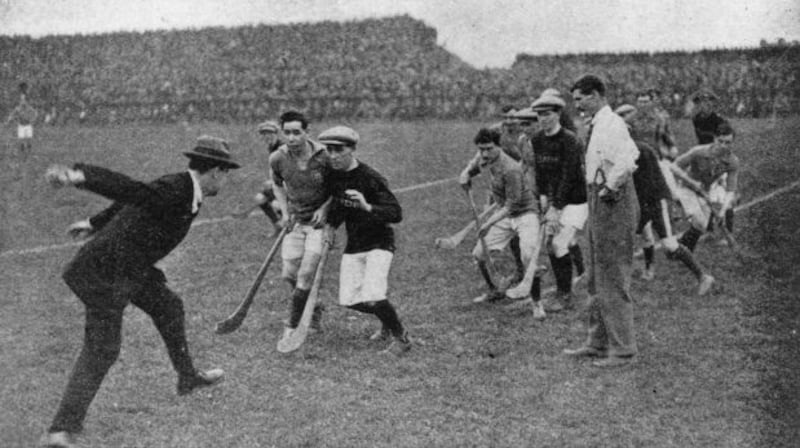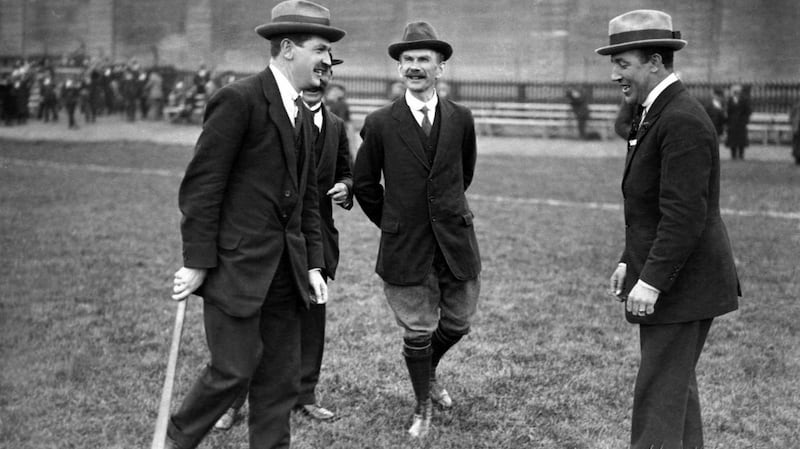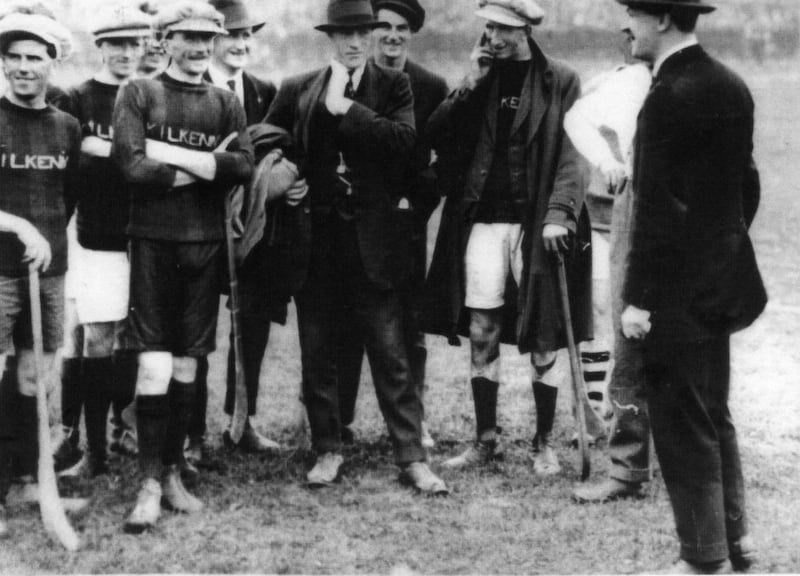By a quirk of fate Michael Collins’s birth and centenary were both marked by his native county of Cork achieving that most unusual of feats, the All-Ireland football and hurling double – two of four occasions on which it happened in GAA history.
The irony is that, despite his involvement in the GAA and the association’s significance in both encouraging and developing key attributes in Collins’s future role in the independence movement, there is little evidence of his activities in local club, Clonakilty.
There is circumstantial support, however. He was only 15 when he arrived in London, and at the youngest, 16 when he became involved with the Geraldines club. By then he was a hurling enthusiast and big for his age so he could compete with adults. At that young age, there would have been little outlet for him at home.
[ Who shot Michael Collins? One hundred years on, the question remains unansweredOpens in new window ]
Nonetheless, Professor Paul Rouse of UCD, the pioneering sports historian, thinks it improbable that Collins arrived in London without any experience of the games.
READ MORE
“It seems very unlikely that he didn’t do something before he left for England. Don’t forget we’re not looking at now when there are Go Games and organised underage structures. Remember also there was no organised sport in primary schools at the time.
“It’s more likely informal play before you graduate to teams.”

Cork chair Marc Sheehan gave the commemorative address at the GAA’s centenary wreath-laying ceremony in Clonakilty on Saturday. He says there is some indication that Collins may have played for the club later when visiting home.
“West Cork would be predominantly and particularly at that time staunchly football. There does seem to be some evidence that he played in the 1909 football championship with Clonakilty. A local historian here, Tommy Lyons, believes he was listed on a team by his full name, Michael Collins, rather than his initials.
“Possibly he was back on holidays or if the match was in the early part of the year, back for Christmas. But apart from that, there seems little or no involvement at club level here. His focus was on Geraldines, which was based in the Notting Hill area before relocating to Edmonton in north London where it remained until its dissolution in 1999.”
Dr William Murphy of DCU is co-founder with Rouse of Sports History Ireland and, with Trinity College’s Dr Anne Dolan, co-author of a Collins biography and the newly published Collins diaries.
[ The Hollywood star who provides a living link to the death of Michael CollinsOpens in new window ]
He traces Collins’s involvement with the GAA and its importance. Given that even the most generous accounts emphasise the young Cork man’s enthusiasm rather than his skill, the most fascinating aspect of this involvement is the administrative talent displayed.
“With the Geraldines club, he’s in on the ground floor. They’re a very young, small club when he joins and he’s with them from 1908 and made vice-captain quite quickly, which suggests that he’s reasonably handy but he’ll also turn up!
“He becomes secretary of the club from 1909, which means he’s a very young man, still in his teens. He’s very active. There’s records of him chasing people for their membership fees and Croke Park have those secretary’s reports from Geraldines.

“These are interesting. He’s obviously a wry, self-aware person from early on. You could also say that he grasps at this stage the importance of the secretary’s role in an organisation. Time and again he becomes the secretary of various bodies and there’s a sense that whereas it’s not a glamorous role it’s where real influence and power lie within an organisation.
“He becomes very effective at building what we’d call these days networks, but for all the practical application of what he learns within the GAA, he is genuinely interested in the games.
“If you look at the diaries for 1919, he’s noting down the results of championship matches – the defeat of Wexford (defending four-in-a-row football champions) and the emergence of Kildare. He’s keeping results. Whether that means he was at the matches or not is another matter but I suspect he would have been at some of them.”
After his return from London in early 1916, the GAA and Croke Park feature prominently in Collins’s life during the revolutionary period. The association frequently ran challenge matches as benefits for political prisoners and their families, a cause which Collins hugely supported.
[ How The Irish Times reported the shooting of Michael Collins 100 years agoOpens in new window ]
The work with the Irish Republican Prisoners’ Dependents’ Fund, Murphy says, was essentially his entrée into the highest councils of the IRB.
Bloody Sunday began with the killing of British army personnel on the morning of November 21st, 1920, encompassed the retaliatory murder of 14 civilians that afternoon in Croke Park and concluded with the deaths of Dick McKee and Peadar Clancy, two senior IRA operatives and Conor Clune, who had the misfortune to be mistaken for another.
Collins had masterminded the morning action and strongly advised the GAA not to proceed with the Dublin-Tipperary match for fear of retribution. Ironically, GAA general secretary Luke O’Toole felt that to call off the fixture would be to imply a connection between the association and the IRA.
The GAA may not have been uniformly republican but from Collins’s perspective, the association and its headquarters were important, according to Murphy.

“He’s using it as a space to meet people. I think the GAA is a social lubricant and he has strong associations with people like PS Ó hÉigeartaigh and Sam Maguire and Austin Stack and Harry Boland. They have shared revolutionary interests as well but you get the impression that their shared interest in the GAA didn’t do any harm to how they got on, at a personal level.”
Also in Croke Park, there are now iconic photographs of him, seated with Arthur Griffith and Éamon de Valera and throwing the ball in for the 1921 Leinster hurling final.
Murphy explains the context of the former, before a football challenge between the recent All-Ireland finalists, Wexford and Tipperary.
“It’s the first appearance of De Valera in public after he escapes from Lincoln Jail in February 1919. Reports – not always reliable – put the attendance at 25,000 and more than £1,000 was raised for prisoner support.”
[ The final day in the life of Michael CollinsOpens in new window ]
The second picture prompted an interesting piece on last year’s centenary by Sky Sports’ Brian Barry, whose great-grandfather Joseph Coyne is the Dublin player at the forefront of the throw-in.
In it he cites contemporary reports admiring Collins’s participation in a pre-match puck-around with his friend and future Civil War adversary Harry Boland, whose own centenary fell at the end of July and who was very active in the GAA and had hurled for Dublin in an All-Ireland final and also refereed the 1914 football final between Kerry and Wexford.
“It was nothing new to see Harry Boland in Croke Park with his camán,” read the match report in the Irish Independent. “Many a time has his unerring stroke brought victory to the Faughs. But when Michael Collins had a few preliminary shots before he started the match yesterday we realised that he, too, had handled a hurley before.”

For Rouse, Collins’s involvement in the GAA prefigured his future prominence in the struggle for independence.
“Absolutely everything Collins became. You can see the gathering personality. Absolutely given to doing the hard yards and working away. Enough confidence in himself to take a position but enough about him to make sure he did it properly. He wasn’t just in it for the sake of office; he wanted to advance the games.
“He loved hurling and football and was interested in them. He wasn’t just there as a nationalist dutifully following the national sport. He loved the games. You can see it looking at that photo in Croke Park in 1921. These aren’t lads who are posing for more than the camera – that’s enthusiasm.
“That’s not putting a hurley in the hand of someone who’s never held one before. He looks comfortable and up for it.”
– Days in the Life, Reading the Michael Collins Diaries 1918-1922, by Anne Dolan and William Murphy, is published this week.
















